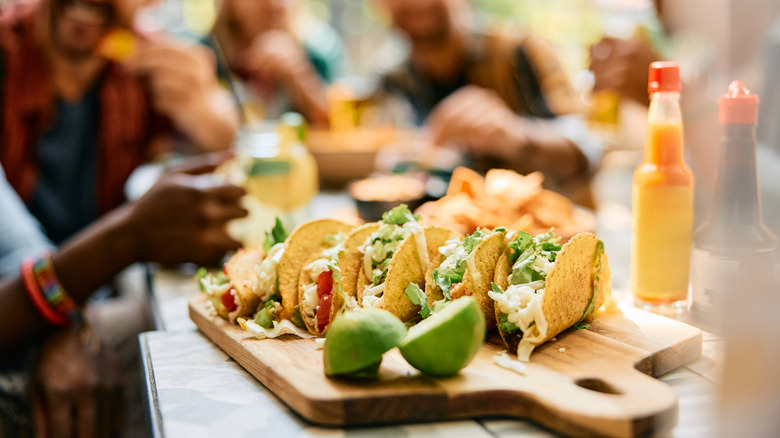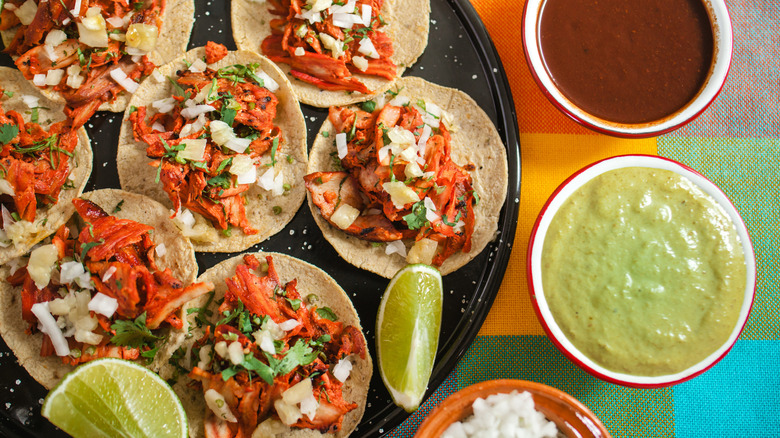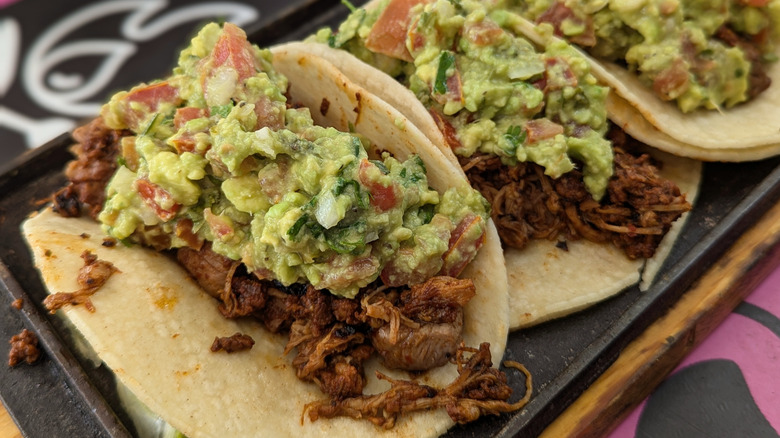The Guacamole Alternative You Can Pour Right On Tacos
When I first saw guacachile, I was like, "What even is that?!" I like to consider myself a connoisseur of Mexican cuisine, and I was somehow unaware of guac's little cousin. Also known around Mexico as "fake guacamole," this silky smooth condiment is quickly gaining recognition as a versatile and flavorful alternative for some of your favorite Mexican food items.
What's unique about the sauce is that it looks like a smoother version of guacamole but doesn't actually contain avocados (perfect because avocados are expensive). In addition, this sauce is totally pourable, whereas guacamole is typically chunky and served as a dip.
What makes guacachile particularly appealing is its bold flavor profile, which is still relatively simple and not overpowering for whatever you use it on. Guacamole blends ingredients like onions, tomatoes, and cilantro with the avocado, so you get a creamy and balanced flavor, but it doesn't always contain spicy peppers like jalapenos. With guacachile, the absence of the avocado means the sauce isn't as creamy.
The light green color is typically from using green chiles along with lime juice and fresh herbs like cilantro. When these ingredients are blended, they produce a vibrant, light green mixture that resembles guacamole in color but has a distinct flavor and texture. The liquid components give it a smoother consistency, and the tangy, slightly spicy sauce is heavenly when drizzled over tacos. It's also delicious in quesadillas and burritos. It's beneficial to understand how this sauce is made and why it's earning a spot on tables around the world in place of guacamole.
How to make guacachile
Guacachile consists of fresh green chilies (such as serranos or jalapeños), lime juice, garlic, water, and salt. The preparation of guacachile is simple but relies on the freshness of its components. The chilies are the star of the show, delivering a bright, spicy kick. Lime juice provides a tangy counterbalance to the heat, and the garlic adds a nice depth to the flavor. You'll have a fragrant, vibrant, tasty sauce when all ingredients are blended together; water is used to achieve the desired pourable consistency.
In some variations, fresh herbs like cilantro or a splash of olive oil are added for extra flavor. You can also use guacachile with grilled meats, roasted vegetables, or tortilla chips. Guacachile is not only versatile but also incredibly easy to prepare, so it's a popular choice in Mexican cuisine. The only downside is that if you're not at a restaurant and trying to make it at home, you'll need a blender to get the right consistency; that's not the case for guacamole.
Why choose guacachile over guacamole?
Guacachile offers a fresh alternative to guacamole for those who enjoy bolder, spicier flavors. Guacamole is thick and creamy, while guacachile is thinner, tangy, and refreshing, with a heat-forward profile that improves a wide range of dishes. Its lighter texture makes it ideal for drizzling, so every bite of your meal is evenly coated with flavor.
For tacos, guacachile provides a sharper, zestier complement to the smoky or savory flavors of the filling. It's also perfect for grilled meats and seafood, where its acidity helps balance the richness of the proteins. Compared to guacamole, guacachile doesn't do too much to steal the show from the dishes you pour it onto; instead, it enhances its natural flavors.
Another advantage of guacachile is its simplicity. It requires fewer ingredients than guacamole and is easier to prepare. Without the need for ripe avocados, it's a reliable option year-round — regardless of produce availability.


